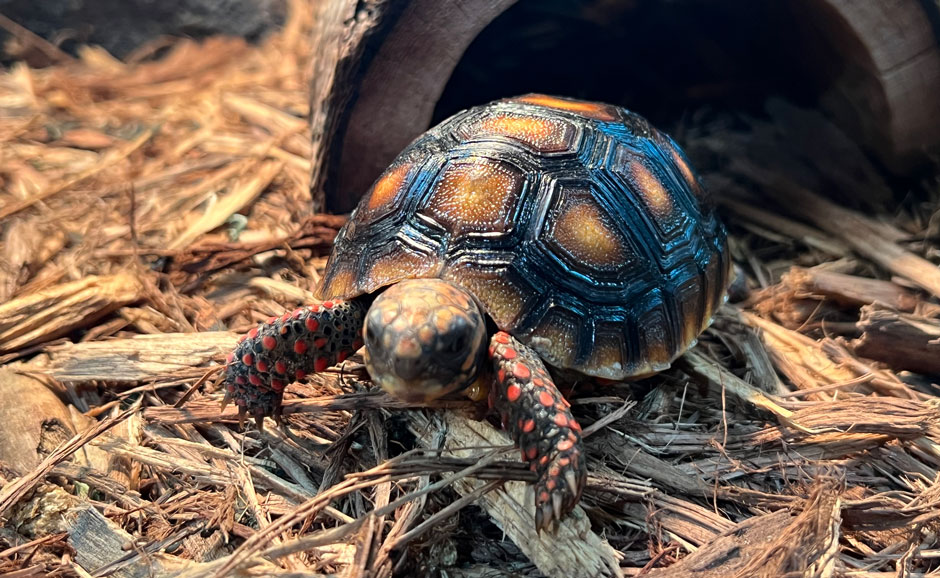Are you considering bringing a fascinating pet to your home, mainly a cherry head tortoise? Doubtlessly, these charming creatures captivate all eyes towards them and are gaining popularity rapidly. But do you want to know if you can have a cherry-headed tortoise as a pet?
In this article, we’ll discuss everything that will help you get the answer to your question. You’ll get all the necessary information, from the pros and cons of owning these pets to diet, habitat requirements, and physical characteristics.
So let’s dive deep into the content and explore everything about your cherry-headed friend!
Physical Characteristics
It’s important to note that cherry head tortoises are a type of red-footed tortoise. They are native to South America and are named for their reddish or orangish spots on their heads and limbs and have dark shells.
These friendly creatures are manageable in size and can reach up to 12 inches in length. Furthermore, they weigh up to 10 pounds. And what about their lifespan? If you bring a cherry tortoise into your home, it can live up to 50 years in captivity.
What are the Pros and Cons of Owning Cherry Head Tortoises?
These fascinating creatures can be great companions for each pet lover. Granted they have a long listing of pros, but they also have some drawbacks. Let’s uncover both to know these pets in detail.
Pros
Here are some of the major pros that you must know:
- Long Lifespan
They have a long lifespan of 50 or more so they serve as a long-term companion.
- Low Maintenance
Cherry-headed tortoises can easily thrive in a simple enclosure, requiring minimal attention and low maintenance.
- Unique Appearance
Due to their distinctive markings and vibrant orange-red head, these creatures keep a unique appearance that distinguishes them from other tortoises.
Cons
Now let’s move towards the cons:
- High Cost
Bringing a cherry-headed tortoise can cost you high compared to other pets. That’s because their total cost includes the cost of a pet, setting up the enclosure, and heating and lighting requirements.
- Size and Space Requirements
Regardless of their small size, these pets still require a spacious area in their enclosure to thrive.
- Messy Eaters
These species are called messy eaters due to their propensity of spreading food all over their habitats. That’s what makes their enclosure dirty frequently.
Do They Have Any Specific Habitat Requirements?
As discussed earlier, the cherry head tortoises require a spacious enclosure with enough space to move around and hide. Thus, their enclosure should be at least 4 feet long by 2 feet wide.
Furthermore, their enclosure should have a basking spot that reaches 90-95°F and a cooler side that stays around 70-80°F.
Diet and Nutrition for Cherry Head Tortoises
Diet and nutrition is the point you must pay attention to. These tortoises require a diet high in fiber and low in protein and fat. What’s more, serve them a variety of diets with fruits, vegetables, and leafy greens. In addition to this, their diet should also have occasional protein sources such as boiled eggs or insects. And don’t forget to access them with fresh water all the time.
Health and Wellness Considerations
Knowing your pet tortoise’s health and wellness considerations is something you must not ignore. Here are some of the common health issues that are found in a pet cherry head tortoise:
- Respiratory infections
- Metabolic Bone Disease
- Shell Rot
In addition to this, the signs of illness or injury to look for include:
- Discharge from the Eyes or Nose
- Lack of Appetite
- Lethargy
Therefore, regular veterinary care is essential for keeping cherry head tortoises safe and healthy.
Some Effective Tips for Owning a Cherry Head Tortoise
Here are some of the most effective tips that you must know to ensure the well-being of your cherry tortoise:
- Keep their enclosure at least four times the length and two times the width of the tortoise.
- Keep the enclosure’s temperature regulated, between 80-85°F during the day and no lower than 70°F at night.
- Give them easy access to natural sunlight or UVB lighting so they produce vitamin D3 and maintain their metabolism.
- Keep their enclosure clean by removing waste and uneaten food, keeping them safe from parasitic infections.
- Never make the mistake of overfeeding, keeping them in environments that are too dry or humid, and overhandling them.
- Keep checking if your pet tortoise has any illness or injury, like swollen eyes or lethargy. Consult a vet if you find any signs in them.
Final Words
Without any doubt, if you keep your cherry head tortoises with specialized care, they can make rewarding pets. For this, always prioritize their diet, hydration, and habitat maintenance.
If you follow the effective tips discussed above, we are sure you can provide a safe and comfortable environment for your cherry head tortoise to thrive in. Most importantly, always consult a veterinarian if you have concerns about your cherry-headed tortoises’ health.

